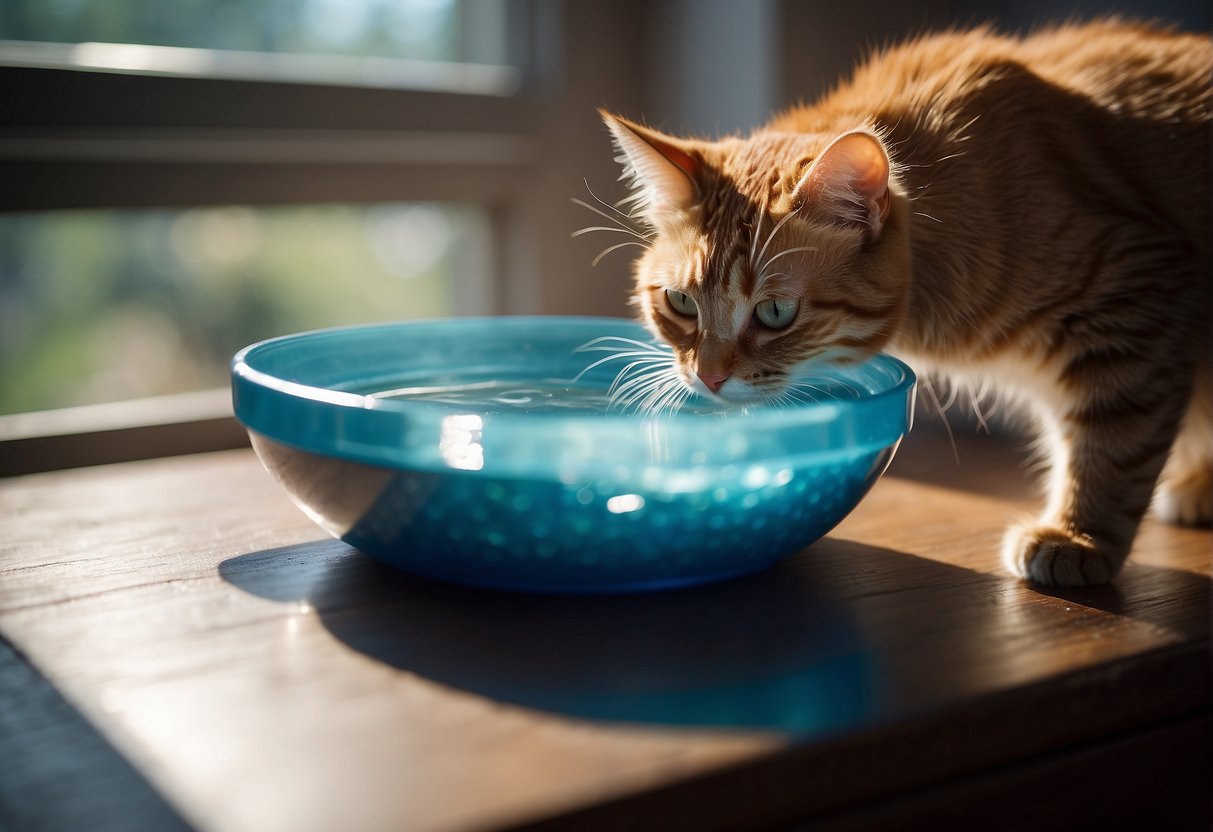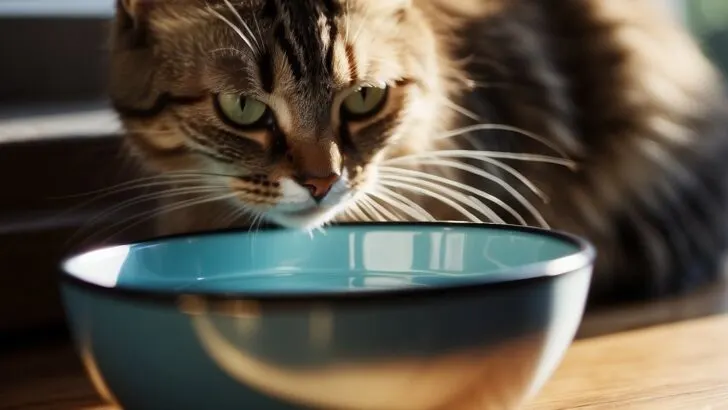Ensuring your cat has fresh water every day is crucial for their health and hydration. From personal experience, I’ve seen how a fresh bowl of water can encourage my felines to drink more regularly, supporting their kidney function and overall wellbeing.
Cats, being the particular creatures they are, prefer their water to be clean—much like how they groom themselves to keep their fur immaculate.

Keeping the water clean is also important because a bowl left out can become a breeding ground for bacteria which could potentially harm your cat. In my own routine, I make it a point to refresh the water at least once daily, and more frequently if it gets dirty or contaminated with food or debris.
If you’ve ever noticed how your cat might be hesitant to drink, consider the freshness of their water; it often makes a noticeable difference.
Staying on top of hydration needs is essential, especially since cats have a low thirst drive and may not drink enough if the water isn’t appealing. While water from a cat’s food can contribute to their hydration, it isn’t enough on its own.
An adequate supply of fresh water complements their diet and is a simple step to maintain your cat’s health.
Cat Hydration Needs

Keeping your cat hydrated is a fundamental aspect of their health. Ensuring they have access to fresh water promotes well-being and can prevent a range of health issues.
Importance of Clean Water
Your cat is instinctively driven to seek out water that is fresh and clean, similar to the running streams their ancestors might have drunk from in the wild. Clean water is vital to maintain your cat’s health, impacting everything from digestion to urinary tract health. Stagnant or dirty water can dissuade them from drinking, potentially leading to dehydration.
Dehydration Risks
Dehydration occurs when your cat’s water intake is lower than their water loss. Signs to look out for include lethargy, dry gums, and decreased skin elasticity.
Dehydration can seriously affect your feline’s health, leading to issues such as urinary tract complications. Cats need approximately 4 ounces of water per 5 pounds of body weight daily.
Hydration and Health Conditions
Adequate water intake is not just about quenching thirst; it supports essential bodily functions and can be critical for cats with certain health conditions. For example, a cat with a history of urinary tract issues needs constant hydration to help flush out their system, which can prevent recurrence of such problems. Digestive regularity also relies heavily on hydration.
Maintaining your cat’s hydration is more than just providing water; it’s about ensuring their overall health is looked after.
Choosing the Right Water Bowl
When selecting a water bowl for your cat, it’s not just about picking up any dish and filling it with water. The right choice can significantly affect your cat’s drinking habits and overall health.
Types of Water Bowls
There are a variety of cat water bowls available, each with its own advantages. The main types are:
- Standard bowls: These are the typical water dishes and come in various sizes.
- Automatic waterers: These provide a constant supply of water, which is great for cats that prefer fresh running water.
- Water fountains: Many cats are attracted to running water, and fountains can encourage them to drink more frequently.
Material Benefits
When it comes to the material of the cat water bowl, each brings something unique to the table:
- Stainless steel: Durable, easy to clean, and less likely to harbor bacteria.
- Ceramic: Heavy, stable, and often come in stylish designs that can be a great match for your home decor.
It’s important to note that plastic bowls, while inexpensive, can scratch easily, creating places for bacteria to grow. Plus, some cats may develop allergies to plastic, leading to a condition known as feline acne.
Water Bowl Location
Finding the perfect spot for your cat’s water bowl can make a huge difference. Keep in mind:
- The location should be quiet and accessible, away from litter boxes and food dishes.
- Cats often prefer their water source to be in a different location than their food, as it can be reminiscent of their instinctual behavior in the wild.
Maintaining Your Cat’s Water Supply
Ensuring your cat has access to clean water every day is crucial for their health and well-being. The quality and freshness of your cat’s water can greatly affect their hydration and overall health. Let’s break down the important aspects of water maintenance for your feline friend.
Cleaning Schedule
Daily: Empty and rinse the water bowl to remove any debris or food particles. This prevents the build-up of bacteria and maintains freshness.
Weekly: Use hot water and dish soap to scrub the bowl. Rinse thoroughly to avoid soap residue.
For water fountains:
- Weekly: Disassemble the fountain and clean all parts, including the pump, to keep water flowing smoothly and to prevent white bubbles from foam.
- Monthly: Replace foam filters and clean or replace carbon filters to ensure proper filtration and to keep the water tasting great.
Water Freshness
Providing fresh water daily is non-negotiable. Cats prefer fresh, oxygenated water, which is why many are attracted to running taps.
Replace the water at least once a day, more often if you notice dirt or if multiple cats are using the same bowl. Remember, stagnant or still water is a no-no, as it can encourage bacterial growth.
For water fountains:
- Change the water every few days to maintain freshness and to prevent organic matter from settling.
Filtering Water
Filtration systems in pet fountains play a key role in maintaining fresh drinking water. They aid in removing dirt, debris, and chemicals, thus improving the taste and quality of your cat’s water.
- Carbon filters: Capture impurities and chemicals, providing cleaner water.
- Foam filters: Trap larger debris such as hair or dry food, extending the lifespan of the water pump.
It’s important to follow the manufacturer’s instructions and maintain a replacement schedule for filters to ensure the benefits of filtration continue. Regular filter changes also prevent the filtration system from becoming a hotbed for bacterial growth.
Encouraging Your Cat to Drink More
By setting up a cat-friendly water system and incorporating moisture-rich foods, you can ensure your feline friends stay happily hydrated.
Multiple Water Sources
To entice your cats to drink more water, consider scattering multiple water sources throughout your home. Just like humans, cats appreciate variety and convenience when it comes to hydration:
- Different Locations: Place water bowls in various spots your cat frequents. This can be near their food bowl, in their favorite lounging spots, or even in quiet corners for the more reserved felines.
- Variety of Bowls: Experiment with different materials like stainless steel, ceramic, or glass. Some cats may have a preference that could dictate how much they drink.
- Maintain Water Level: Always keep the water level full so that your cat’s whiskers don’t touch the sides of the bowl, which can be irritating for them.
Incorporating Wet Food
Adding wet food to your cat’s diet is a straightforward way to boost their moisture intake:
- Wet Food Advantages: Wet food can provide a significant amount of your cat’s daily water needs. It’s especially beneficial for encouraging hydration and supporting urinary tract health.
- Balanced Diet: Ensure a balance between wet and dry food. Dry food is good for their dental health, while wet food helps with hydration.

My name is James, and welcome to FAQCats!
Along with our team of cat owners, expert pet enthusiasts, and pet professionals, we aim to write engaging helpful, engaging content about cats. At FAQCats we strive to provide content that’s accurate and fun to read. Our team writes about everything related to cats; even the most complex of topics. Through extensive research and caring for our own fur-pals, we’re able to provide something cat owners worldwide will love. Have a look around, and leave us feedback anytime!

